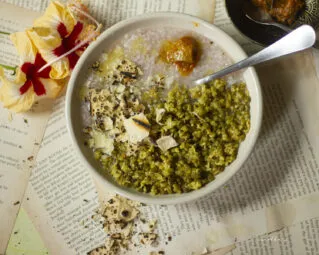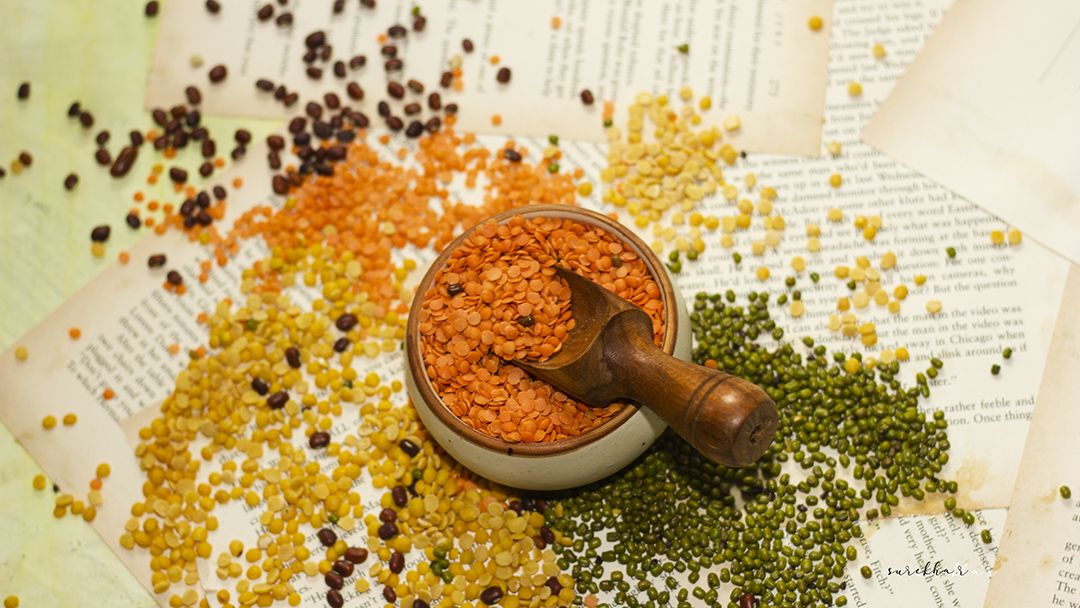Are you a vegan?
Are you lactose intolerant? Or just can’t stand the smell of milk?
Are you a diehard fan of the jeera rice and dal fry combo?
Are you looking for a pocket-friendly health food option?
Then this article is for you.
A recent research about the seed coat of lentils caught my attention.
Scientists in ICRISAT have proved that the seed-coat of Tur dal contains 6 times more calcium than milk does. The human body needs about 800-1000 mgs of calcium per day. Researchers have also found that the amount of calcium in pigeon pea seed coat is much higher when compared rice bran, wheat bran and oat bran. These seed coats can be incorporated into our diet as supplements and as plant-based microcapsules. This can help cure calcium deficiencies in both, adults and children.
What intrigued the foodie in me and made me delve deeper into lentils was the beautiful picture of a Tur dal plant laden with pods along with this research.
Let us see some nutrition facts about lentils:
• Lentil is a legume with the highest amount of protein other than soya beans.
• The soluble fibres in lentils help in stabilising blood sugar levels and reduces the risk of getting type 2 diabetes.
• Lentils are naturally gluten-free and cholesterol free.
• Lentils are a good source of Vitamin A, Vitamin C ( antioxidants ), and minerals like iron, magnesium, and zinc.
• They also have a high content of tannin, a phytochemical that prevents cancer growth.
• The folic acid and magnesium present in lentils is good for artery walls and thus provide heart health.
• 100 gm of cooked lentils contains 116 calories, 9.2 gm proteins, 0.38 gm fat, 20.13 gm carbohydrates, 7.9 gm fibre and 1.8 gm sugar.
These legumes are considered survival foods in regions of high altitudes and in places where there is a scarcity of food because they are easy to store, are available at a reasonable prices and have a shelf life of over 30 years
Loving lentils a little more, aren’t you? But wait!
There is more to the lentils.
Lentils are Divine.
‘’ KUNDALINI AN UNTOLD STORY ‘’ is a national bestseller book By Sri OM SWAMI JI. In this book, lentils are mentioned as the favourite ‘Nivedyam‘ of Sakini Devi, the presiding deity of the mooladhar chakra or the root chakra.“Devi likes’ Mudgaudana”. Mudgaudana is a soup of beans and rice. Mudga ideally refers to black gram dal or black lentil. Mastery over the root chakra enhances bone health and heightens the sense of sound, touch, smell, form and taste. In order to have great health and for the overall well-being, we need to have a healthy mooladhara chakra.
The latin phrase “Phaseolus mungoor Vigna mungo”, has a hidden disclosure stating that during the six months of meditation on the root chakra, you should regulate your diet containing more beans and rice.
Science has proven the intake of lentils is good for bones due to their great calcium content. Isn’t it amazing to notice the convergence of science and the science of Kundalini? I am overwhelmed!
You will now look at lentils with a great deal of love.
Today I had breakfast of ‘Kanji and Payaru‘ accompanied with roasted papad, lime pickle, and ghee. The smell of papad getting roasted on the grill along with Kanji and Payaru slowly spreading in the entire kitchen fills me with nostalgia.
Papad and pickle are the real tastemakers for this yummy treat. In my village, there was a lone Brahmin lady Kaveri Amma who used to make papads and sell them home to home. Childless and deserted by her husband homemade papads were her sole revenue. My Granny was one of her regular customers. Yes, the papad had its own signature. The sight of this stoic woman clad in a worn out silk saree drying papads in the sun is unforgettable.
Whenever I am confused or a little low in energy, I resort to having a diet of Kanji and Payaru. I eat it for breakfast, lunch and dinner and forget about the world and its worries.. I grew up in a culture where Kanji and vegetable curry were the norms for breakfast. Kanji and curry always rejuvenated, calm and healed me. The royals as well as the common man relish this healthy porridge in Kerala.
Many years back, there were also community halls where the poor were served Kanji and curry. In Ayurveda as well, Kanji is the food served to patients who are undergoing treatment because it is light and easy to digest.
Green grams are known to improve heart health, reduce the risk of diabetes and promote weight loss. The rich iron content in them helps the production of red blood cells. It is an antioxidant and helps to reduce diseases caused by damaging free radical reactions in the blood.
Recipe Time 😊
RICE CONGEE (KANJI)(PORRIDGE)

INGREDIENTS :
2 cups broken red rice
4 to 5 cups of water (Enough water to boil )
A pinch of salt.
PREPARATION
· Wash the rice with water three or four times.
· Boil the water
· Add the rice to boiling water and cook till tender and becomes a porridge.
· Add a pinch of salt , and garnish with a spoonful of cow ghee. Consume hot with the curry.
PAYARU (boiled green gram)

This simple side dish of boiled green gram along with coconut is a great combination with Kanji and Puttu. It can be relished with Puri and chapatti also.
Let us see how to make this protein-packed dish.
• 500 gm Payar (Whole Green gram)
• 1 cup grated coconut
• 2 garlic cloves
• 1 tsp red chilli powder
• ½ tsp cumin seeds
• Salt
• Oil
• Mustard, curry leaves, chopped shallots, and red chillies for tempering.
PREPARATION :
Boil the green lentils with salt in a cooker or pan till done. Drain any excess water. Coarsely grind coconut, cumin seeds, and a garlic clove. . Add the chilli powder. Mix the coconut paste with the cooked lentils. Heat two teaspoons of coconut oil in a pan. Splutter the mustard and sauté the other ingredients for tempering. Add the lentils mixture to this. Mix well. Simmer with a lid on for a few more minutes before serving.
NUTRITIONAL BENEFITS OF GREEN GRAMS:
( Sourced from WIKIPEDIA )
Energy: 347 kcal per 100gm.
Carbohydrates: 62.62 gm
Sugars: 6.6 gm
Dietary Fibre: 16.3 gm
Fat: 1.15 gm
Protein: 28.86 gm
Vitamins: Thiamine (B1) 54% , Riboflavin (B2) 19% Niacin (B3 ) 15% Pantothenic Acid (B5 )38% Vitamin B6 ,29 % Folate (B9 ) 156%, Vitamin C , 6 % Vitamin e 3 %
Minerals: Calcium 13%, Iron 52%, Magnesium 53%, Manganese 49%, Phosphorous 52%, Potassium 27% Zinc 28%
These facts about these powerful legumes are mind-blowing indeed!
To be continued…
The link to The book ” Kundalini an untold story ” by Sri Om Swami ji is here
Jai Sri Hari
Meanwhile 🙂










Comments & Discussion
20 COMMENTS
Please login to read members' comments and participate in the discussion.